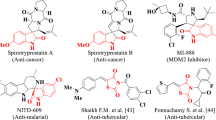Abstract
A series of 1-benzo[1,3]dioxol-5-yl-indoles bearing 3-N-fused heteroaryl moieties have been designed based on literature reports of the activity of indoles against various cancer cell lines, synthesized via a Pd-catalyzed C-N cross-coupling, and evaluated for their anticancer activity against prostate (LNCaP), pancreatic (MIA PaCa-2), and acute lymphoblastic leukemia (CCRF-CEM) cancer cell lines. A detailed structure–activity relationship study culminated in the identification of 3-N-benzo[1,2,5]oxadiazole 17 and 3-N-2-methylquinoline 20, whose IC50 values ranged from 328 to 644 nM against CCRF-CEM and MIA PaCa-2. Further mechanistic studies revealed that 20 caused cell cycle arrest at the S phase and induced apoptosis in CCRF-CEM cancer cells. These 1-benzo[1,3]dioxol-5-yl-3-N-fused heteroaryl indoles may serve as a template for further optimization to afford more active analogs and develop a comprehensive understanding of the structure–activity relationships of indole anticancer molecules.




Similar content being viewed by others
References
Kaushik NK, Kaushik N, Attri P, Kumar N, Kim CH, Verma AK, Choi EH (2013) Biomedical importance of indoles. Molecules 18:6620–6662
Chadha N, Silakari O (2017) Indoles as therapeutics of interest in medicinal chemistry: bird’s eye view. Eur J Med Chem 134:159–184
Kumar S, Ritika (2020) A brief review of the biological potential of indole derivatives. Futur J Pharm Sci 6:121
Dhiman A, Sharma R, Singh RK (2022) Target-based anticancer indole derivatives and insight into structure-activity relationship: a mechanistic review update (2018–2021). Acta Pharm Sin B 12:3006–3027
Jordan A, Hadfield JA, Lawrence NJ, McGown AT (1998) Tubulin as a target for anticancer drugs: agents which interact with the mitotic spindle. Med Res Rev 18:259–296
Jordan MA, Wilson L (2004) Microtubules as a target for anticancer drugs. Nat Rev Cancer 4:253–265
Brancale A, Silvestri R (2007) Indole, a core nucleus for potent inhibitors of tubulin polymerization. Med Res Rev 27:209–238
Patil SA, Patil R, Miller DD (2012) Indole molecules as inhibitors of tubulin polymerization: potential new anticancer agents. Future Med Chem 4:2085–2115
Kaur R, Kaur G, Gill RK, Soni R, Bariwal J (2014) Recent developments in tubulin polymerization inhibitors: an overview. Eur J Med Chem 87:89–124
Patil R, Patil SA, Beaman KD, Patil SA (2016) Indole molecules as inhibitors of tubulin polymerization: potential new anticancer agents, an update (2013–2015). Future Med Chem 8:1291–1316
Naaz F, Neha K, Haider MR, Shafi S (2021) Indole derivatives (2010–2020) as versatile tubulin inhibitors: synthesis and structure-activity relationships. Future Med Chem 13:1795–1828
Saruengkhanphasit R, Butkinaree C, Ornnork N, Lirdprapamongkol K, Niwetmarin W, Svasti J, Ruchirawat S, Eurtivong C (2021) Identification of new 3-phenyl-1H-indole-2-carbohydrazide derivatives and their structure–activity relationships as potent tubulin inhibitors and anticancer agents: a combined in silico, in vitro and synthetic study. Bioorg Chem 110:104795
Herr RJ (2002) 5-Substituted-1H-tetrazoles as carboxylic acid isosteres: medicinal chemistry and synthetic methods. Bioorg Med Chem 10:3379–3393
Myznikov LV, Hrabalek A, Koldobskii GI (2007) Drugs in the tetrazole series. (Review). Chem Heterocycl Compd 43:1–9
Pettit GR, Singh SB (1987) Isolation, structure, and synthesis of combretastatin A-2, A-3, and B-2. Can J Chem 65:2390–2396
Desbène S, Giorgi-Renault S (2002) Drugs that inhibit tubulin polymerization: the particular case of podophyllotoxin and analogues. Curr Med Chem Anti-Cancer Agents 2:71–90
Lu Y, Chen J, Xiao M, Li W, Miller DD (2012) An overview of tubulin inhibitors that interact with the colchicine binding site. Pharm Res 29:2943–2971
Yi X, Zhong B, Smith KM, Geldenhuys WJ, Feng Y, Pink JJ, Dowlati A, Xu Y, Zhou A, Su B (2012) Identification of a class of novel tubulin inhibitors. J Med Chem 55:3425–3435
Hassan RM, Abd-Allah WH, Salman AM, El-Azzouny AAS, Aboul-Enein MN (2019) Design, synthesis and anticancer evaluation of novel 1,3-benzodioxoles and 1,4-benzodioxines. Eur J Pharm Sci 139:105045
Pettit GR, Singh SB, Hamel E, Lin CM, Alberts DS, Garcia-Kendall D (1989) Isolation and structure of the strong cell growth and tubulin inhibitor combretastatin A-4. Experientia 45:209–211
Mollinedo F, Gajate C (2003) Microtubules, microtubule-interfering agents and apoptosis. Apoptosis 8:413–450
Heravi MM, Kheilkordi Z, Zadsirjan V, Heydari M, Malmir M (2018) Buchwald-Hartwig reaction: an overview. J Organomet Chem 861:17–104
Diana P, Stagno A, Barraja P, Montalbano A, Carbone A, Parrino B, Cirrincione G (2011) Synthesis of the new ring system pyrrolizino[2,3-b]indol-4(5H)-one. Tetrahedron 67:3374–3379
Barraja P, Diana P, Carbone A, Cirrincione G (2008) Nucleophilic reactions in the indole series: displacement of bromine under phase transfer catalysis. Tetrahedron 64:11625–11631
Beigelman L, Buckman B, Wang G, Matulic-Adamic J, Stoycheva AD, Andrews SW, Misialek SM, Rajagopalan PTR, Fryer AM, Gunawardana I, Haas J, Huang L, Madduru MR, Zhang G, Kossen K, Serebryany V (2008) Novel inhibitors of hepatitis C virus replication. WO 2008/100867 A2
Wittenberger SJ, Donner BG (1993) Dialkyltin oxide mediated addition of trimethylsilyl azide to nitriles. A novel preparation of 5-substituted tetrazols. J Org Chem 58:4139–4141
Acknowledgements
We are grateful to the National Health Research Institutes and the National Science and Technology Council of Taiwan (105-2113-M-400-002) for financial support. We also thank Dr. Hsin-Ru Wu of the Instrumentation Center of National Tsing Hua University for HPLC MS measurements.
Author information
Authors and Affiliations
Contributions
C.-H.Y., P.-W.C., H.-H.H., and Y.-C.C. synthesized the desired indoles. M.-H.W. and S.-H.W. performed the biological activity evaluation and mechanistic studies. J-.S.S. supervised the experiments of biological activity evaluation and mechanistic studies. J.-C.L. designed the experiments, analyzed the data, supervised the project, and wrote the manuscript. All authors reviewed the manuscript.
Corresponding author
Ethics declarations
Competing interests
The authors declare no competing interests.
Additional information
Publisher's Note
Springer Nature remains neutral with regard to jurisdictional claims in published maps and institutional affiliations.
Supplementary Information
Below is the link to the electronic supplementary material.
Rights and permissions
Springer Nature or its licensor (e.g. a society or other partner) holds exclusive rights to this article under a publishing agreement with the author(s) or other rightsholder(s); author self-archiving of the accepted manuscript version of this article is solely governed by the terms of such publishing agreement and applicable law.
About this article
Cite this article
Yao, CH., Wu, MH., Chang, PW. et al. Design, synthesis, and anticancer evaluation of 1-benzo[1,3]dioxol-5-yl-3-N-fused heteroaryl indoles. Mol Divers 28, 595–608 (2024). https://doi.org/10.1007/s11030-023-10605-x
Received:
Accepted:
Published:
Issue Date:
DOI: https://doi.org/10.1007/s11030-023-10605-x




